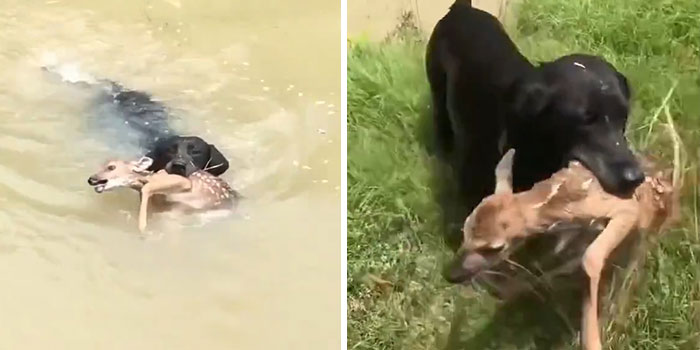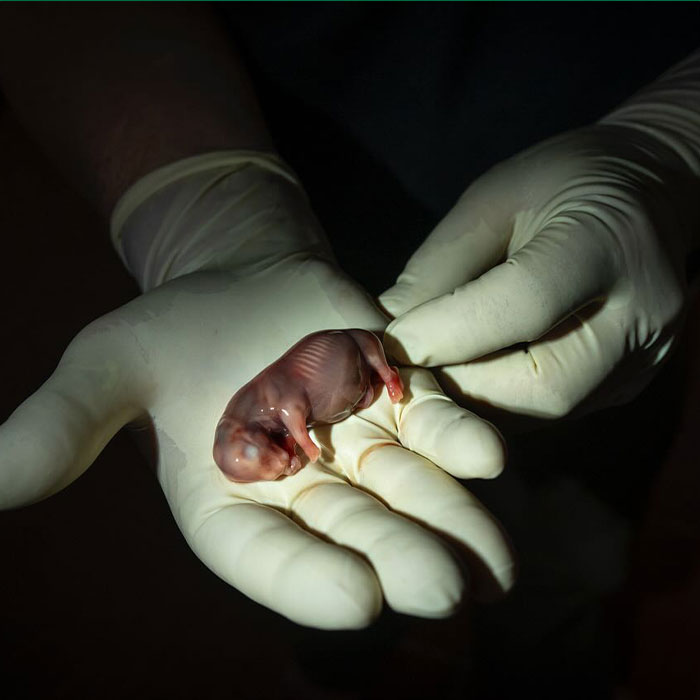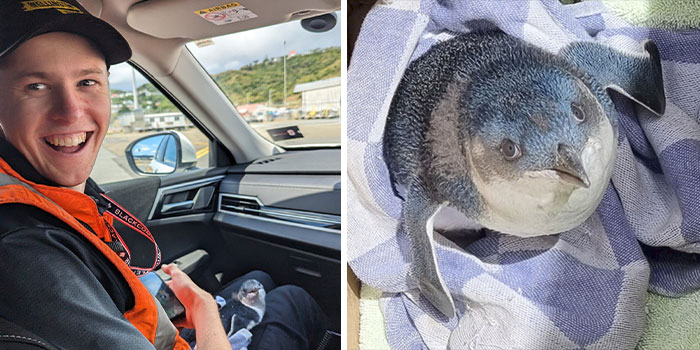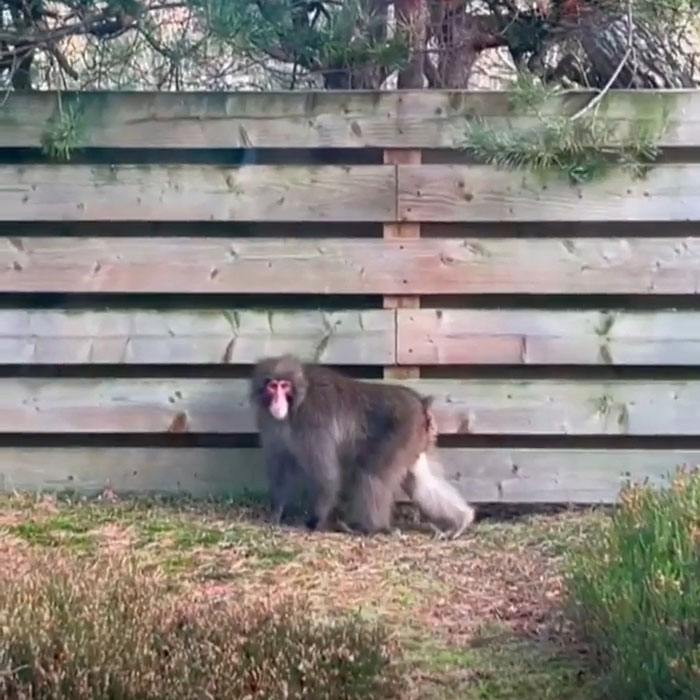It goes without saying that the Internet is a never-ending museum of irresistibly cute animal content. In fact, not only can you be enthralled by the thousands of adorable videos and photos shared daily, but you can also learn about the most recent and exciting scientific breakthroughs in the animal kingdom.
Luckily, January saw multiple fascinating stories about the natural world around us. From unlikely interspecies friendships that saved lives to studies proving a link between sleep deprivation and reproduction, we've had quite a busy month for animal-related news.
Bored Panda has selected seven captivating animal stories that have made headlines during the first month of the year.
This post may include affiliate links.
Deer Fawn Rescued From Drowning
At first glance, you might think that the viral video posted on X (formerly known as Twitter) showing a dark animal with a deer fawn in its jaws wouldn’t end well.
But the horror quickly turns into heartwarming surprise when you realize that the dark shadow isn’t a hungry alligator but a heroic black labrador retriever rescuing the little fawn from drowning.
“Made my day,” the user who re-posted the video wrote on the social media platform.
After the remarkable feat, the owner of the dog can be heard behind the camera praising it for saving the baby deer’s life, as the little fawn, evidently scared, kept bleating.
And yet some people still question the ability of compassion among animals.
World’s First Rhino Ivf Pregnancy Offers Hope For Nearly-Extinct Species
With just two females remaining, Northern white rhinoceros are considered the most endangered species on the planet. But this could change thanks to IVF.
Scientists and conservationists have successfully transferred an embryo into a southern white rhino surrogate, a major breakthrough that opens the door to transferring northern white rhino embryos in the future.
“The embryo transfer technique is well established for humans and for domesticated animals such as horses or cows. But, for rhinos, it has been completely uncharted territory,” Thomas Hildebrandt, BioRescue project head at the Leibniz Institute for Zoo and Wildlife Research, told The Telegraph.
“It took many years to get it right, and we are overwhelmed that we now have proof that this technique works perfectly.”
Since the 1960s, the northern white rhino population has fallen from 2,000 to just two remaining females today, mother and daughter Najin and Fatu, who are protected at Ol Pejeta Conservancy near Mount Kenya with 24-hour armed security.
This sharp decline in numbers can be explained by several factors, such as poaching—illegal trafficking and killing of wildlife— habitat loss, and civil war.
A Very Unusual Visitor At New Zealand Airport
On the afternoon of January 12, an Air Chathams pilot of the Wellington Airport in New Zealand spotted a baby blue penguin (also called a kororā) on the airport's runway minutes before takeoff.
"The pilot and passengers patiently waited while Wellington Airport staff raced out to collect and help the visitor," the airport announced on an Instagram post.
"We’ve done some penguin proofing to our fences to keep our flippered friends out of trouble in future," the post added.
The lost animal, only six weeks old, was taken to the Wellington Zoo to get veterinary care at a zoo section called "The Nest."
According to the airport’s Wildlife Officer Jack Howarth, the penguin was in a "less-than-impressed mood," which he attributes to the runway sensors reading 50 degrees.
“It’s a very unusual occurrence, and there’s no record of a penguin visiting us like this before,” he said.
In a video shared by the Wellington Zoo of the penguin being cared for, staff members said that the little visitor "probably got lost on the way home."
First-Ever Sighting Of A White Shark Pup
Wildlife filmmaker Carlos Gauna and UC Riverside biology doctoral student Phillip Sternes were scanning the waters for sharks near Santa Barbara on California’s central coast when they spotted a shark pup unlike any they’d ever observed, the University of California shared in an official press release on January 29.
Great whites, referred to as white sharks by scientists, are gray on top and white on the bottom. However, the roughly 5-foot-long shark that appeared on the drone camera’s viewfinder was pure white.
After enlarging the images, the duo realized that the predator’s white layer was being shed from its body as it was swimming, leading them to believe that they had spotted, for the first time in history, a white shark, and that the fearless creature was shedding its embryonic layer.
“Where white sharks give birth is one of the holy grails of shark science. No one has ever been able to pinpoint where they are born, nor has anyone seen a newborn baby shark alive,” Gauna said of the exciting finding.
“There have been dead white sharks found inside deceased pregnant mothers. But nothing like this.”
In the weeks leading up to the unprecedented sighting, the filmmaker had observed the presence of large, likely pregnant great whites in this location, which seems to confirm that he spotted a pup of the endangered shark species, believed to be “hours” or “a day old, at most.”
Screech Owl Safely Captured From Connecticut Home
A Connecticut family’s game night looked a bit different during the last days of January, as the household was joined by an unlikely guest: an owl perched on a shelf among a game of Battleship and Kidz Cardz.
After the Screech owl was found, the West Hartford Police responded along with an animal control officer and staff from A Place Called Hope rehabilitation center to get the rogue bird back to his natural habitat.
Christine Cummings, the president of A Place Called Hope, believes the owl, presumed to be a male based on his size, found his way into the home’s basement via an uncovered chimney stack that led to a furnace clean-out in the basement or a fireplace.
“This owl was very hungry and dehydrated upon admission,” Cummings explained. “Lucky for him, nothing was broken. We don’t know how long he had been trapped indoors.”
The Eastern Screech owl was later taken to an aviary space in preparation for release to the property.
“The owl was safely captured and has been rehabilitated by the rescue. As of this post, the owl is doing great and said to be released shortly,” the West Hartford Police said in a Facebook post.
Small Male Marsupials Trade Sleep For Sex
Scientists have recently discovered that a species of mouse-sized male marsupials in Australia, named antechinus, are willing to sacrifice hours of sleep for reproductive activities. What’s more, tiny male antechinus die once their intense mating season is over.
The study is the first to show direct evidence for this type of “extreme” sleep restriction in any land-dwelling mammal, CNN reported.
“Animals that are long-lived, like humans and elephants, don’t have this pressure to reproduce in a short period of time. They have the luxury of being able to sleep as long (as) they want (and) need each day,” Erika Zaid, lead author of the study, told the news outlet.
However, the story changes for this marsupial species, which live for 11 months, and can only breed once in their lifetime.
This pressure drives them to compete with other males to reproduce with as many females as possible before dying shortly after their first (and last) mating season.
Males sleep three hours less per night, every night, for three weeks (approximately the length of the mating period) compared to females, who can reproduce more than once, data showed.
Still, the difference between males and females was not significant, Zaid explained, which may suggest that females are similarly sleep-deprived due to male harassment during the mating period.
Humans have the luxury of sleep as long as we want? Why didn't anyone tell me!!
Monkey On The Run In Scotland
On January 28, a Japanese macaque, also known as a snow monkey, escaped from the Cairngorm National Park in Scotland. Zookeepers responded by deploying thermal image drones to locate the elusive wild animal.
The macaque’s escape was first noted by locals, who saw him in a garden in the nearby village of Kincraig.
After its escape, the monkey, called Honshu, was spotted stealing from bird feeders and running through the small town of Kingussie in Scotland, the Royal Zoological Society of Scotland said.
"It’s just the most surreal thing. I’ve seen snow monkeys in the wild, but you don’t expect to see them in your back garden in the Highlands," Carl Nagle, who saw the seven-year-old primate from his patio door, told The Independent.
Following a five-day search, the rebellious monkey was finally recaptured yesterday (February 1) after a drone team shot him with a tranqulizer, the BBC reported.
Now this is the type of content we want on BoredPanda. None of that AITA nonsense and angry Karen crud.
What, no mention of the New Jersey bull? https://www.youtube.com/watch?v=-PP0h9WATLY
Nice one! This news clip has better footage, IMHO, and a good look at the fella: https://www.youtube.com/watch?v=su2nRD3ItTc
Load More Replies...Now this is the type of content we want on BoredPanda. None of that AITA nonsense and angry Karen crud.
What, no mention of the New Jersey bull? https://www.youtube.com/watch?v=-PP0h9WATLY
Nice one! This news clip has better footage, IMHO, and a good look at the fella: https://www.youtube.com/watch?v=su2nRD3ItTc
Load More Replies...
 Dark Mode
Dark Mode 

 No fees, cancel anytime
No fees, cancel anytime 





































































